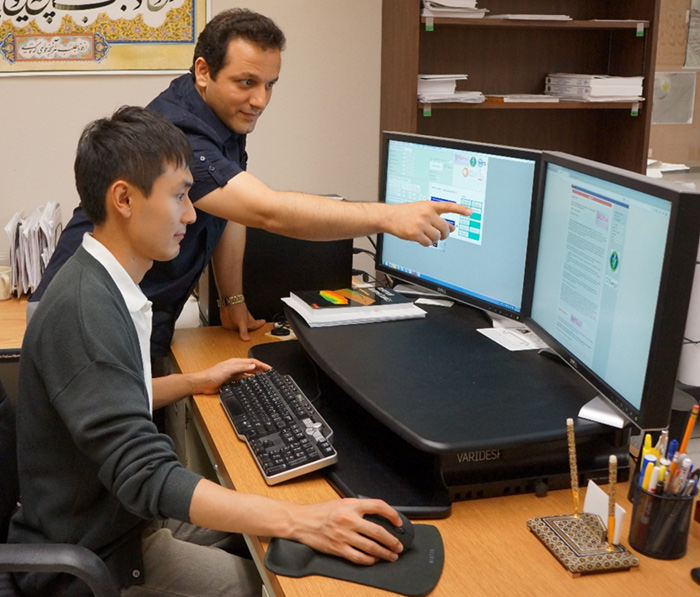Seyyed Hosseini
What are your current research activities?
For the past 5 years, I have been focusing mainly on two research topics: (1) development of monitoring plans for CO2 injection fields with special focus on use of pressure data, and (2) application of reservoir engineering and fluid-flow fundamentals in the understanding of subsurface behavior of fluids in relation to CO2 injection and hydrocarbon production.
What excites you the most about your current research?
In recent years, although many advances have been made in the area of subsurface fluid-flow modeling, very few have been as successful and widely used by industry as those approaches developed in the 20th century. I believe there is still work that can be built directly on those pioneering works with applied outcomes. It is very exciting to take those old-school type of reservoir-engineering methods one step further and push their application boundaries.
What is the desired outcome of your research?
The desired outcome of my research is to find applied solutions for our current problems related to the understanding of fluid flow in the subsurface. This involves an improvement in our understanding of nature. I believe nature and its behavior have many signs for us to study and learn from. To me, nature is the ultimate teacher of solutions for the problems that we are trying to solve. If we succeed in finding those answers, we should be able to develop tools and methods with direct application to our scientific problems.
What do you need in order to make your research efforts more successful?
As a recent research scientist, I need to focus on a couple of specific research ideas that have been engaging me for some time. In order to make this happen, I should be able to set aside enough time to focus on the research problems. The main issue is getting funding to spend time on these topics, which sometimes can be challenging. Also, current funding sources sometimes require me to distance myself from what I actually like to do in order to focus on deliverables of the projects. I assume this is something that everybody struggles with.
What are your latest papers/publications, and what is most exciting to you about them?
For the last 3–4 years, I have been working on developing an idea for using pressure-pulse testing for monitoring CO2 injection projects. I have published two journal papers and several abstracts and presentations on this topic, and it seems this approach is getting more attention. In addition, our research group had the opportunity to deploy this idea in commercial projects in Texas. I am excited to see how this method is going to develop in the future and if it can become a routine procedure in monitoring plans for CO2 injection projects.
Who will benefit from your latest paper or publication?
My research on monitoring injection processes can potentially benefit several groups. It can help oil and gas companies/field operators ensure that their money invested in a project is protected and that the proper level of monitoring is in place. Other beneficiaries of these methods are people living around the CO2 injection sites. These monitoring methods can potentially find possible issues and protect resources (such as drinking water, etc.) that directly affect all of our daily lives. In addition, government agencies use the results of our research to inform their regulations and to put in place required monitoring plans and policies to ensure public safety while also ensuring that industry can progress and prosper.

What was your most exciting past paper or publication, and why?
I have one paper published on the development of a novel method to estimate initial gas in place in unconventional gas reservoirs. Its methodology is derived from fluid-flow fundamentals and uses laboratory data to directly provide an estimate of the amount of gas in core samples. Two other papers related to the application of harmonic pulse testing to detect CO2 leakage have resulted in exciting outcomes. Again, in these papers I take old-school type of reservoir engineering methods one step further and develop new applied methodologies for industry use.
Who are the types of research partners you are seeking?
Mostly researchers and faculty members with interest in fluid-flow modeling in porous media. Recently, I have been extending my research to some laboratory experiments (upon completion of BEG’s new and renovated laboratory buildings), and I have a couple of interesting ideas to research. I am looking to partner with researchers with more experimental backgrounds, as well.
What are the desired relationships, expertise, or skills that could be brought in to benefit your research?
We have had quite a number of engineers added to BEG in recent years, which has been great. Bringing in some experimental engineers and technicians with laboratory experience would be interesting for me to collaborate with in new research areas.
What have been recent successes associated with your research (grants, awards, patents, etc.)?
My most recent grant as PI was awarded by the DOE in 2015. We received around $1.5M from NETL to design and investigate the effect of brine extraction in relieving the pressure buildup in CO2 storage formations.
What is the geographic location of your research?
My current research is mostly focused on U.S. shore projects (mostly Gulf Coast states), but applications are general and can be adopted anywhere else. In years prior to joining the BEG, I have worked on projects in Russia, the Middle East, and Kazakhstan.
To learn more about the research and publications discussed in this article, please contact Seyyed Hosseini.